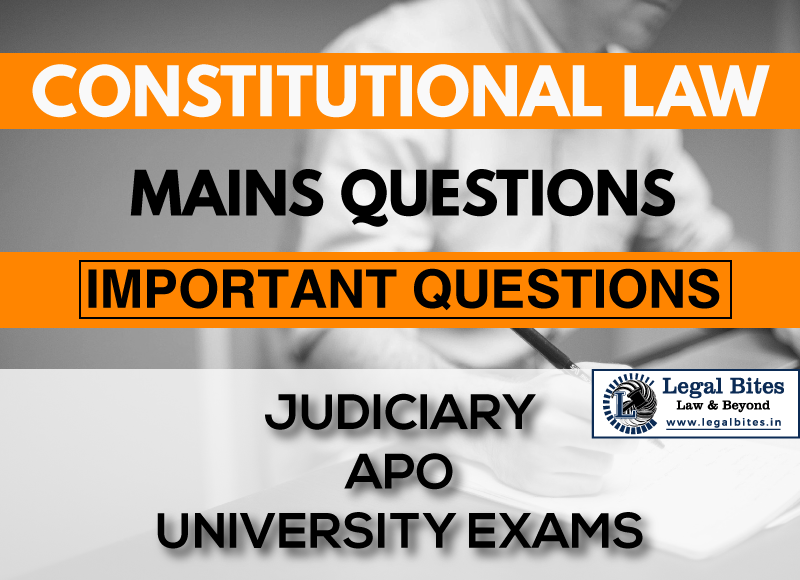“The Power of Parliament to amend the Constitution is limited”. Examine this statement critically in view of the Constitution (24th and 42nd) Amendment Acts and Supreme Court decisions in that regard.
Question: “The power of Parliament to amend the Constitution is limited”. Examine this statement critically in view of the Constitution (24th and 42nd) Amendment Acts and Supreme Court decisions in that regard. Find the answer to the mains question only on Legal Bites. [“The power of Parliament to amend the Constitution is limited”. Examine this statement critically in… Read More »

Question: “The power of Parliament to amend the Constitution is limited”. Examine this statement critically in view of the Constitution (24th and 42nd) Amendment Acts and Supreme Court decisions in that regard. Find the answer to the mains question only on Legal Bites. [“The power of Parliament to amend the Constitution is limited”. Examine this statement critically in view of the Constitution (24th and 42nd) Amendment Acts and Supreme Court decisions in that regard....
Question: “The power of Parliament to amend the Constitution is limited”. Examine this statement critically in view of the Constitution (24th and 42nd) Amendment Acts and Supreme Court decisions in that regard.
Find the answer to the mains question only on Legal Bites. [“The power of Parliament to amend the Constitution is limited”. Examine this statement critically in view of the Constitution (24th and 42nd) Amendment Acts and Supreme Court decisions in that regard. [BJS 2000]
Answer
Article 368 of the Indian Constitution enshrines the powers of Parliament to amend the Constitution and its procedure. Though our Constitution grants the power of bringing amendment on the Parliament, it is not absolute and the limitation of Parliament’s power of amendment is a basic feature of the constitution. Thus, Parliament cannot enlarge this limited power into absolute power. The procedural limitation on the power of amendment is laid down in Article 368 itself. That the basic feature of the constitution cannot be amended, is an inherent and implied limitation on Parliament’s power of constitutional amendment.
24th amendment, 1971
Earlier cases decided that the term ‘law’ under Article 13 of the Constitution includes the constitutional amendments. But following the 24th Amendment Act, 1971, a new clause (4) was added to Article 13 which says that ‘nothing in this article shall apply to any amendment of this Constitution made under Article 368.’ This means the basic structure of the constitution cannot be taken away or amended by any law passed by the Parliament.
This was decided in the Kesvananda Bharati v. State of Kerala [(1973) 4 SCC 22] case, in which the Supreme Court declared that Article 368 did not enable Parliament to alter the basic structure or framework of the Constitution and parliament could not use its amending powers under Article 368 to ‘damage’, ’emasculate’, ‘destroy’, ‘abrogate’, ‘change’ or ‘alter’ the ‘basic structure’ or framework of the constitution. This decision is not just a landmark in the evolution of constitutional law, but a turning point in constitutional history because it overruled the earlier decision which granted the Parliament with excessive power to even bring an amendment that would have an effect on the basic structure of the constitution.
42nd Amendment, 1976
The next case in which the Supreme Court had occasion to apply the Kesavananda ruling regarding the non-amenability of the basic features of the Constitution was Indira Nehru Gandhi v. Raj Narain [AIR 1975 SC 2299]. Here Supreme Court declared Clause 4, Article 329A as unconstitutional. It violated essential features of the Constitution, i.e. democratic feature in the case. The after-effects of the judgment led to the quick passage of an Amendment which is also known as the Mini Constitution i.e. 42nd Amendment Act, 1976. It was made as the government desired to ensure that never in the future, the courts have the power to pronounce a constitutional amendment invalid. But this amendment was again struck down in the case of Minerva Mills v UOI [AIR 1980 SC 1789].
In this case, the scope and the extent of the basic structure doctrine were considered again by Supreme Court. Section 55 of the 42nd Amendment was inserted which deprive the courts of their power to question any constitutional Amendment.
The Court held that Section. 55 is beyond the amending power of the Parliament and void since it sought to remove all limitations on the power of Parliament to amend the Constitution which also conferred such power on Parliament that could destroy or damage the constitution by obstructing its basic or essential features. The true object of these clauses of the 42nd Amendment was to remove the limitation imposed on Parliament’s power to amend the Constitution through Kesavananda’s case.
Therefore, the conclusion is that the limited amending power one of the basic features of the Constitution. Therefore, Parliament cannot expand its amending power under Article 368 in order to acquire for itself the right to abrogate and do away with basic features of the constitution.
Important Mains Questions Series for Judiciary, APO & University Exams
- Constitutional Law Mains Questions Series Part-I
- Constitutional Law Mains Questions Series Part-I
- Constitutional Law Mains Questions Series Part-II
- Constitutional Law Mains Questions Series Part-IV
- Constitutional Law Mains Questions Series Part-V
- Constitutional Law Mains Questions Series Part-VI
- Constitutional Law Mains Questions Series Part-VII
- Constitutional Law Mains Questions Series Part-VIII
- Constitutional Law Mains Questions Series Part-IX
- Constitutional Law Mains Questions Series Part-X
Admin Legal Bites
Legal Bites Study Materials correspond to what is taught in law schools and what is tested in competitive exams. It pledges to offer a competitive advantage, prepare for tests, and save a lot of money.
